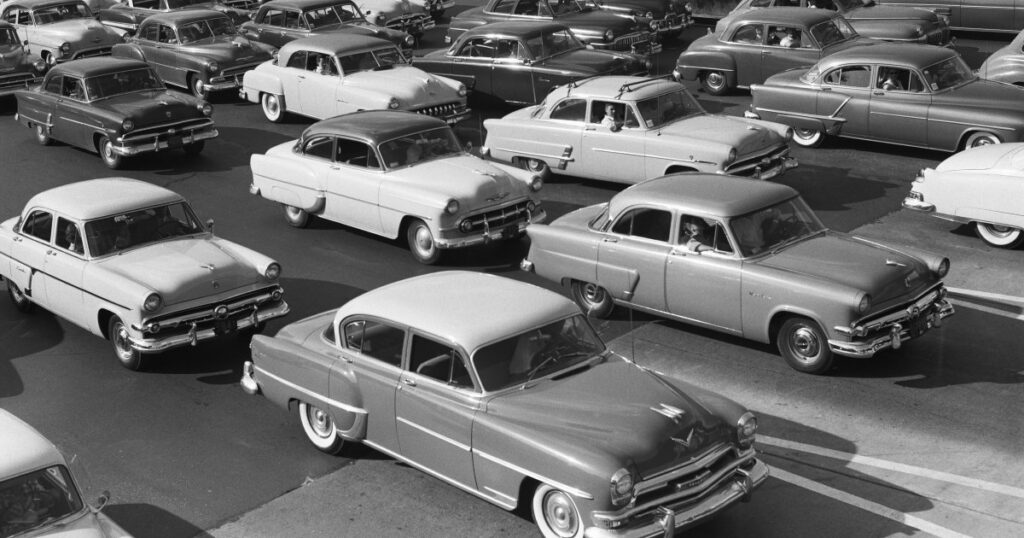H. Armstrong Roberts/Retrofile/Getty Images
This story was originally published by the Guardian and is reproduced here as part of the Climate Desk collaboration.
The United States, with its enormous highways, sprawling suburbs and neglected public transport systems, is one of the most car-dependent countries in the world. But this arrangement of obligatory driving is making many Americans actively unhappy, new research has found.
The car is firmly entrenched as the default, and often only, mode of transport for the vast majority of Americans, with more than nine in 10 households having at least one vehicle and 87 percent of people using their cars daily. Last year, a record 290 million vehicles were operated on US streets and highways.
However, this extreme car dependence is affecting Americans’ quality of life, with a new study finding there is a tipping point at which more driving leads to deeper unhappiness. It found that while having a car is better than not for overall life satisfaction, having to drive for more than 50 percent of the time for out-of-home activities is linked to a decrease in life satisfaction.
“Car dependency has a threshold effect—using a car just sometimes increases life satisfaction but if you have to drive much more than this people start reporting lower levels of happiness,” said Rababe Saadaoui, an urban planning expert at Arizona State University and lead author of the study. “Extreme car dependence comes at a cost, to the point that the downsides outweigh the benefits.”
The new research, conducted via a survey of a representative group of people across the US, analyzed people’s responses to questions about driving habits and life satisfaction and sought to find the link between the two via a statistical model that factored in other variables of general contentment, such as income, family situation, race, and disability.
The results were “surprising,” Saadaoui said, and could be the result of a number of negative impacts of driving, such as the stress of continually navigating roads and traffic, the loss of physical activity from not walking anywhere, a reduced engagement with other people, and the growing financial burden of owning and maintaining a vehicle.
“We need to get the voices of those who can’t drive—disabled people, seniors, immigrants, poor folks—into the room.”
“Some people drive a lot and feel fine with it but others feel a real burden,” she said. “The study doesn’t call for people to completely stop using cars but the solution could be in finding a balance. For many people driving isn’t a choice, so diversifying choices is important.”
Decades of national and state interventions have provided the US with an extensive system of highways, many of which cut deep into the heart of its cities, fracturing communities and bringing congestion and air pollution to nearby residents, particularly those of color.
Planning policies and mandatory car parking construction have encouraged suburban sprawl, strip malls with more space for cars than people, and the erosion of shared “third places” where Americans can congregate. As a result, even very short journeys outside the house require a car, with half of all car trips being under three miles.
Most of the decisions driving this are made at a state level, although Joe Biden’s administration vowed to help rebuild public transit networks beleaguered by the Covid pandemic and to tear down certain divisive highways. However, the federal government has continued pouring far more money into building and expanding roads than in any alternatives to driving. Next year, more than $60 billion in federal funding is planned for roads and bridges.
A small sliver of the American public actively chooses to live without a car because they are able to live in the few remaining walkable communities in the US, but for most of those without a car it is a forced deprivation due to poverty or disability.
Being without a car can itself be expensive and isolating, according to Anna Zivarts, who was born with a neurological condition that prevents her from driving. Zivarts, based in Seattle, is the author of the book When Driving Is Not an Option and advocates on behalf of those unable to drive.
“Seattle has a solid bus system but everyone who can afford a car has a car. I’m often the only parent going to any sort of event without a car. Everything is built around cars,” she said.
“We are just locked into a system of driving that is meant to be more enjoyable but isn’t. I walk five minutes with my kid to the school bus stop and yet other parents make that journey to the stop by car. Is this really how you want to spend your life?”
A long-term effort is required to make communities more walkable and bolster public transport and biking options, Zivarts said, but an immediate step would be simply to consider the existence of people without cars.
“We need to get the voices of those who can’t drive—disabled people, seniors, immigrants, poor folks—into the room because the people making decisions drive everywhere,” she said. “They don’t know what it’s like to have to spend two hours riding the bus.”

